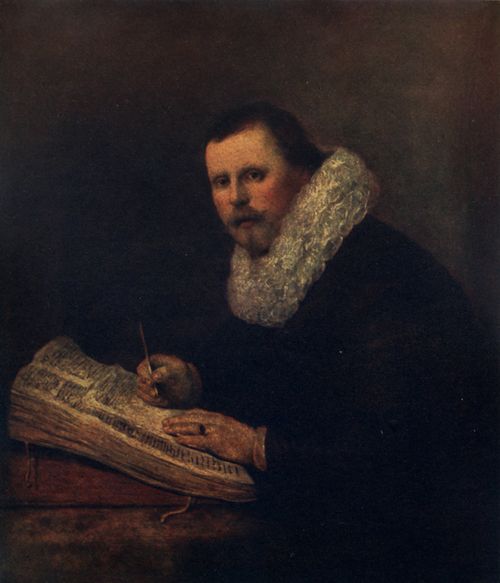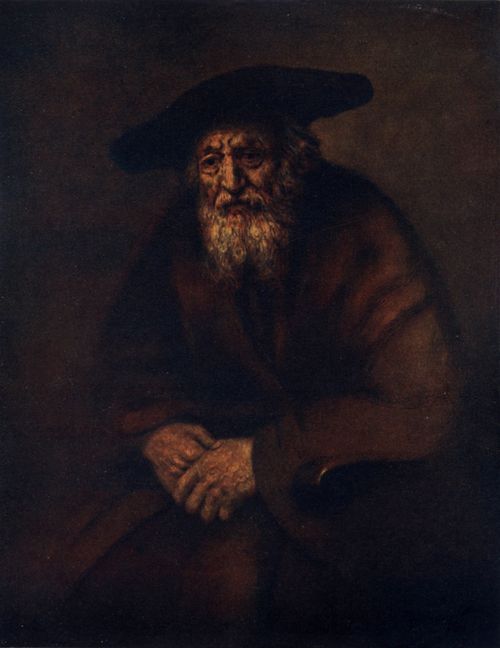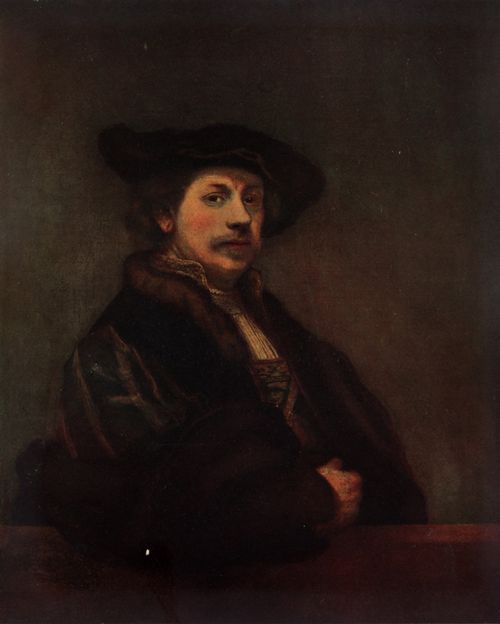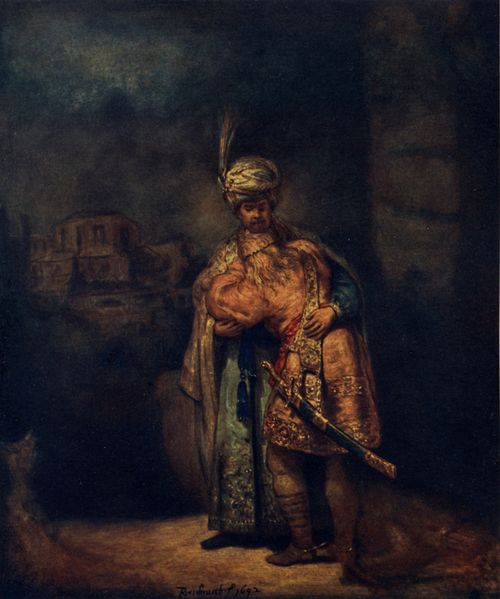








Suppose our citizen and golfer, deliberately dropped in the preceding chapter, had a child, a son, who by a freak of heredity was brooding and imaginative, fond, in a childish way, of pictures and books, but quite indifferent to scientific criticism and the methods of the analytic men. During his school holidays his mother would take him to the pantomime, and to the National Gallery. Dazed, he would scan the walls of pictures, wondering why so many of them dealt with Scriptural subjects, and why some were so coloured, and others so dim.
 PORTRAIT OF A SAVANT
PORTRAIT OF A SAVANT
1631. The Hermitage, St. Petersburg.
But after the third or fourth visit this child began to recognise favourites among the pictures, and being somewhat melancholy and mystical by nature, liking trees, beechwood glades, cathedral aisles, and the end of day, he would drag upon his mother's arm when they passed two pictures hanging together in the Dutch room. One was called The Woman taken in Adultery, the other, The Adoration of the Shepherds. These pictures by Rembrandt attracted him: they were so different from anything else in the gallery. He did not trouble to understand their meaning; he did not dwell upon the beauty of the still figure of Christ, or note that the illumination in The Adoration of the Shepherds proceeded from the supernatural light that shines from the Infant Jesus. What captivated him was the vastness contained in these small pictures, and the eerie way in which the light was separated from the dark. He had never seen anything like it before, but these pictures made him long to be grown up and able to seek such sights. He could see the lurking shadows alone in his bed at night, and held his breath when he thought of the great darkness that stretched out to the frames of the pictures. He wondered if temples were really as mysterious and dim as the great building that loomed above the small dazzling figure of the kneeling penitent and that horrid man who, his mother told him, was one of her accusers.
When she came into his bedroom to see that he was safely tucked up for the night, this child asked his mother why Rembrandt's pictures were so different from the pictures of other painters.
She explained that Rembrandt was a great master of chiaroscuro, making a valiant attempt to pronounce the uncomfortable word.
"What does that mean?" asked the little boy.
"It—er—means—One moment, dear; I think I hear your father calling."
She ran downstairs and consulted the dictionary.
"A chiaroscurist," she told her little boy when she returned to the bedroom, "is a painter who cares for and studies light and shade rather than colour. Now go to sleep. You're too young to bother about such things."
This child's mother was an ardent Ruskinian. Observing that her husband, the citizen and golfer, was asleep in his chair when she returned from her son's bedroom, she stepped into the library, picked Modern Painters from the shelf, and read the following passages, gravely shaking her head occasionally as she read.
"... Rembrandt always chooses to represent the exact force with which the light on the most illumined part of an object is opposed to its obscurer portions. In order to obtain this, in most cases, not very important truth, he sacrifices the light and colour of five-sixths of his picture; and the expression of every character of objects which depends on tenderness of shape or tint. But he obtains his single truth, and what picturesque and forcible expression is dependent upon it, with magnificent skill and subtlety.
"... His love of darkness led also to a loss of the spiritual element, and was itself the reflection of a sombre mind....
"... I cannot feel it an entirely glorious speciality to be distinguished, as Rembrandt was, from other great painters, chiefly by the liveliness of his darkness and the dulness of his light. Glorious or inglorious, the speciality itself is easily and accurately definable. It is the aim of the best painters to paint the noblest things they can see by sunlight. It was the aim of Rembrandt to paint the foulest things he could see—by rushlight...."
Had Ruskin, one wonders, ever seen The Syndics at Amsterdam, or the Portrait of his Mother, and the Singing Boy at Vienna, or The Old Woman at St. Petersburg, or the Christ at Emmaus at the Louvre, or any of the etchings?
The time came when the child was allowed to visit the National Gallery unattended; but although he never lost his affectionate awe for the two dim interiors, he did not really begin to appreciate Rembrandt until he had reached manhood. Rembrandt is too learned in the pathos of life, too deeply versed in realities, to win the suffrages of youth. But he was attracted by another portrait in the National Gallery—that calledA Jewish Rabbi. This was the first likeness he had seen of a Rabbi, a personality dimly familiar to him through the lessons in church and his school Scripture class. Remembering what his mother had told him about chiaroscuro, he noted how the golden-brown light is centred upon the lower part of the face; how the forehead is in shadow, and how stealthily the black hat and coat creep out from the dark background. He had never seen, and never could have imagined, such a sad face. This Rabbi seemed to be crouching into the picture as he dimly understood that Jews in all ages, except those who owned diamond mines in South Africa, had cringed under the hand of their oppressors.
He wondered how Rembrandt knew what a Rabbi was like. His father might have told him that Rembrandt's pencil and brush were never idle, that he was for ever making pictures of himself, of his father, of his mother, of his wife, of his children and relations, of every interesting type that came within the ken of his piercing eyes; that one day, when he was prowling about the Jews' quarter at Amsterdam, he saw an old, tired, wistful Hebrew sitting in the door of his shop, engaged him in conversation, persuaded him to sit for his portrait, and lo! the nameless Amsterdam Jew became immortal.
 AN OLD MAN WITH A LONG WHITE BEARD, SEATED, WEARING A WIDE CAP, HIS HANDS FOLDED
AN OLD MAN WITH A LONG WHITE BEARD, SEATED, WEARING A WIDE CAP, HIS HANDS FOLDED
1654. The Hermitage, St. Petersburg.
His father might also have told him (perhaps he did) that the artist, wherever he goes, sometimes hardly aware of his preoccupation, is always selecting subjects to paint, and brooding over the method of treatment; that one day Rembrandt noted with amusement a man in the street shaking his fist at the skull-capped head of an older man bobbing angrily from a window. Rembrandt chuckled, remembered the incident, painted it, and called it, for a picture must have a title, Samson threatening his Father-in-law; that one day Rembrandt saw a fair-haired, chubby boy learning his lessons at his mother's knee. The composition appealed to his artist eye, he painted it, and the result is that beautiful and touching picture in the Hermitage Gallery at St. Petersburg called Hannah teaching Samuel his Lessons.
To a child, the portrait of a painter by himself has a human interest apart altogether from its claim to be a work of art. Rembrandt's portrait of himself at the National Gallery, painted when he was thirty-two, is not one of his remarkable achievements. It is a little timid in the handling, but that it is an excellent likeness none can doubt. This bold-eyed, quietly observant, jolly-looking man was not quite the presentment of Rembrandt that the child had imagined; but Rembrandt at this period was something of a sumptuous dandy, proud of his brave looks and his fur-trimmed mantle. Life was his province. No subject was vulgar to him so long as it presented problems of light and construction and drawing. Rembrandt, like Montaigne, was never didactic. He looked at life through his eyes and through his imagination, and related his adventures. One day it was a flayed ox hanging outside a butcher's shop, which he saw through his eyes; another day it was Christ healing the sick, which he saw through his imagination. You can imagine the healthy, full-blooded Rembrandt of this portrait painting the Carcase of a Bullock at the Louvre, or that prank called The Rape of Ganymede, or that delightful, laughing picture of his wife sitting upon his knee at Dresden, which Ruskin disliked.
The other portrait of Rembrandt by himself at the National Gallery shows that he was not a vain man, and that he was just as honest with himself as with his other sitters. It was painted when he was old and ailing and time-marked, five years before his death. His hands are clasped, and he seems to be saying—"Look at me! That is what I am like now, an old, much bothered man, bankrupt, without a home, but happy enough so long as I have some sort of a roof above me under which I can paint. I am he of whom it was said that he was famous when he was beardless. Observe me now! What care I so that I can still see the world and the men and women about me—'When I want rest for my mind, it is not honours I crave, but liberty.'"
 REMBRANDT LEANING ON A STONE SILL
REMBRANDT LEANING ON A STONE SILL
1640. National Gallery, London.
Twenty-eight seemed a great age to the child; but he thought it wonderful that the portrait of an Old Lady at the National Gallery should have been painted when Rembrandt was but twenty-eight. She was too strong and determined for his liking, and he wondered why some of Rembrandt's pictures, like The Woman taken in Adultery, should be so mysterious and poetical, and others like this old lady so lifelike and straightforward. He was too young to understand that the composition of the fortuitous concourse of atoms called Rembrandt, included not only the power that Velasquez possessed in so supreme a degree of painting just what his eyes saw, exemplified by this portrait of An Old Lady, aged 83, and by the portrait of Elizabeth Bas at Amsterdam, but that it also included the great gift of creative imagination, exemplified by the Christ at Emmaus, and The Good Samaritan of the Louvre, and in a way by the Portrait of a Slav Prince at the Hermitage, where a man in the alembic of Rembrandt's imagination has become a type. Also in The Reconciliation of David and Absalom at the Hermitage, where behind the sham trappings of the figures shine the eternal motives of reconciliation and forgiveness.
When the child was much older he saw the Christ at Emmaus, and The Good Samaritan in the little room at the Louvre, hanging side by side, and he never forget the hour that he spent with them. He had seen, year by year, many of the world's pictures; but at the sight of these two works, his childish predilection for Rembrandt became a deep-rooted reverence and admiration, which was never to pass from him.
Here was Rembrandt the seer, the man who had suffered. Saskia was dead, his popularity gone; but the effect of these things was but to fill his heart with a world sympathy, with pity for all who sorrow. Again and again he treated the Christ at Emmaus, The Good Samaritan, and The Prodigal Son themes. "Some strange presentment of his own fate," says M. Michel, "seems to have haunted the artist, making him keenly susceptible to the story of The Good Samaritan. He too was destined to be stripped and wounded by Life's wayside, while many passed him by unheeding."
The Christ at Emmaus is a small picture, and small the figures appear in that vast, dimly lighted chamber where the three are seated at table. The spiritual significance of Christ is suggested by most simple means. Light, and intensity of emotion, are the only aids. Rembrandt disdains all other effects. Intense feeling pervades the picture, even in the bare feet of Christ, even in the astonished hand of the disciple resting upon the chair; even in the back of the other disciple who gazes, with clasped hands, transfixed with amazement and love at the face of his Master, who has just broken bread and thus revealed Himself.
 RECONCILIATION BETWEEN DAVID AND ABSALOM
RECONCILIATION BETWEEN DAVID AND ABSALOM
1642. The Hermitage, St. Petersburg.
Of all Rembrandt's pictures, this was the one that made the profoundest impression upon the child when he had become a man. Other works, such as The Shipbuilder and his Wife at Buckingham Palace,The Syndics of the Drapers at Amsterdam, that ripe expression of Rembrandt's ripest powers, convinced him of the master's genius. He was deeply impressed by the range of portraits and subject-pictures at the Hermitage Gallery, many of which, by the art of Mr. Mortimer Menpes, have been brought to the fireside of the untravelled; but the Christ at Emmaus revealed to him the heart of Rembrandt, and showed him, once and for all, to what heights a painter may attain when intense feeling is allied with superb craftsmanship.
He found this intensity of emotion again in the Portrait of his Mother at Vienna. The light falls upon her battered, wrinkled face, the lips are parted as in extreme age, the hands, so magnificently painted, are folded upon her stick. When we look at Rembrandt's portrait of An Old Woman at the Hermitage Gallery, with that touch of red so artfully and fittingly peeping out from between the folds of her white scarf, we feel that he can say nothing more about old age, sad, quiescent, but not unhappy; when we look at the portrait of An Old Lady in the National Gallery (No. 1675) we feel that he can tell us no more about old age that still retains something that is petty and eager; but in the portrait of his mother at Vienna, Rembrandt, soaring, gives us quite another view of old age. It is the ancient face of a mother painted by a son who loved her, who had studied that face a thousand times, every line, and light, and aspect of the features, and who stated all his love and knowledge upon a canvas.
Rembrandt was always inspired when he painted his own family. There is a quality about his portraits of father, mother, Saskia, Titus, and Hendrickje, yes! and of himself, that speaks to us as if we were intimates. It is a personal appeal. We find it in every presentment that Rembrandt gives us of another figure which constantly inspired his brush—the figure of Christ. In The Woman taken in Adultery, it is His figure that is articulate: it is the figure of Christ in the Emmaus picture that amazes: it is the figure of Christ that haunts us in a dozen of the etchings.
Slowly the child, now become a man, began, as he thought, to understand Rembrandt. Why did The Singing Boy at Vienna, apart from the quality of the painting, and the joy depicted on that young smiling face, make a personal appeal to him? Because he is Rembrandt's son, Titus; or if Titus was not actually the model, the features and the smile of Titus hovered between the father and the canvas.
 AN OLD WOMAN IN AN ARM CHAIR, WITH A BLACK HEAD-CLOTH
AN OLD WOMAN IN AN ARM CHAIR, WITH A BLACK HEAD-CLOTH
1654. The Hermitage, St. Petersburg.
He found an authentic portrait of Titus in the Wallace collection, painted in 1657, the year after Rembrandt had become bankrupt. It is one of the most charming portraits the master ever produced, a picture that even the most casual frequenter of galleries must pause before and love. A red cap crowns his curly hair, which falls to his shoulders. The face has a sweet expression; but the observant can detect traces of ill-health upon it. Titus died before his father. Father, mother, Saskia, Hendrickje, Titus, had all gone when the old man passed to his rest.
On the opposite wall at the Wallace collection is The Parable of the Unmerciful Servant, a fine example of Rembrandt the chiaroscurist, straightforward, but touched with that mystery so rare in painting, but which, under certain conditions, was as natural to Rembrandt as drawing. It is not always present in his work. None can say that there is any mystery about the sober portrait pictures called The Wife of Jan Pellicorne with her Daughter, and Burgomaster Jan Pellicorne with his Son, in the Wallace collection. A scriptural subject was needed to inspire Rembrandt's brush with the sense of mystery.
It was the mystery of two pictures at the National Gallery that first drew the child to Rembrandt: it was the etchings that gave him a deeper insight into Rembrandt's sense of mystery, and made of him a willing Gamaliel at the master's feet.